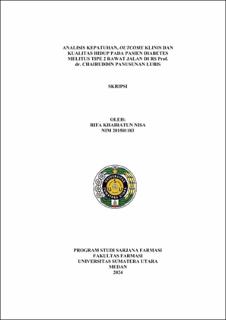| dc.contributor.advisor | Nasution, Embun Suci | |
| dc.contributor.advisor | Rambe, Rima Elfitra | |
| dc.contributor.author | Nisa, Rifa Khairatun | |
| dc.date.accessioned | 2024-09-30T03:37:19Z | |
| dc.date.available | 2024-09-30T03:37:19Z | |
| dc.date.issued | 2024 | |
| dc.identifier.uri | https://repositori.usu.ac.id/handle/123456789/97892 | |
| dc.description.abstract | Background: Diabetes mellitus is a chronic disease that requires long-term
treatment where high treatment adherence will result in good clinical outcomes.
Objective: To determine the differences in patient characteristics with adherence,
clinical outcomes, and quality of life and the relationship between adherence,
clinical outcomes, and quality of life, as well as the relationship between clinical
outcomes and quality of life of outpatient type 2 diabetes mellitus patients at Prof.
dr. Chairuddin Panusunan Lubis Hospital.
Methods: Descriptive cross-sectional study using MARS-5 questionnaire to assess
compliance, clinical outcome data in the form of GDP and BMI levels, and DQoL
questionnaire to assess quality of life. This study was conducted in December 2023-
March 2024 at Prof. dr. Chairuddin Panusunan Lubis Hospital.
Results: The results of the study obtained 114 respondents (respondent rate 85.6%).
The majority of patients were female (60.3%); aged 56-65 years (44.9%); the last
education was a bachelor's degree (41.6%), retired / not working / housewife
(68.2%); long suffering > 5 years (51.4%); and had comorbidities (79.9%). The
compliance rate was non-compliant (62.1%) with uncontrolled GDP (82.7%) and
normal BMI (40.2%) and moderate quality of life (70.1%). The results of the
difference analysis showed that only comorbidities had a significant difference with
compliance and only age had a significant difference with BMI and there was no
significant difference between patient characteristics and quality of life. The results
of the Chi-square test showed that there was no significant relationship between the
level of treatment compliance and clinical outcomes with a very low correlation
value and there was no significant relationship between the level of compliance and
quality of life and there was no relationship between clinical outcomes and quality
of life.
Conclusion: The level of compliance of DM patients was categorized as nonadherent
with uncontrolled GDP and normal BMI and moderate quality of life. Only
comorbidity characteristics had a significant difference with adherence and age had
a significant difference with BMI and there was no difference in characteristics with
quality of life. There was no significant association between adherence and clinical
outcomes, no association between adherence and quality of life, and no significant
association between clinical outcomes and quality of life. | en_US |
| dc.language.iso | id | en_US |
| dc.publisher | Universitas Sumatera Utara | en_US |
| dc.subject | Type 2 Diabetes Mellitus | en_US |
| dc.subject | Adherence | en_US |
| dc.subject | Clinical Outcome | en_US |
| dc.subject | Quality of Life | en_US |
| dc.subject | Prof dr Chairuddin Panusunan Lubis Hospital | en_US |
| dc.subject | SDGs | en_US |
| dc.title | Analisis Kepatuhan, Outcome Klinis dan Kualitas Hidup pada Pasien Diabetes Melitus Tipe 2 Rawat Jalan di RS Prof Dr Chairuddin Panusunan Lubis | en_US |
| dc.title.alternative | Analysis of Adherence, Clinical Outcomes and Quality of Life in Patients with Diabetes Melitus Type 2 Outpatients in Prof Dr Chairuddin Panusunan Lubis Hospital | en_US |
| dc.type | Thesis | en_US |
| dc.identifier.nim | NIM201501183 | |
| dc.identifier.nidn | NIDN0014128004 | |
| dc.identifier.kodeprodi | KODEPRODI48201#Farmasi | |
| dc.description.pages | 151 Pages | en_US |
| dc.description.type | Skripsi Sarjana | en_US |


